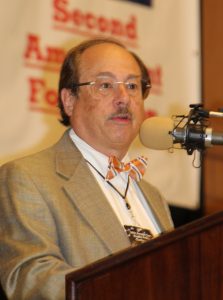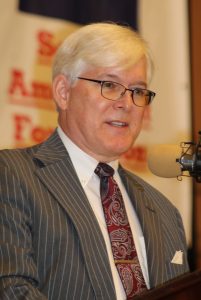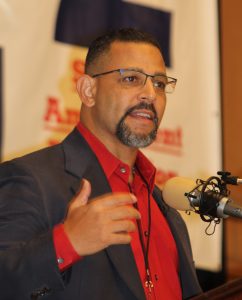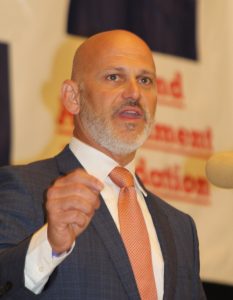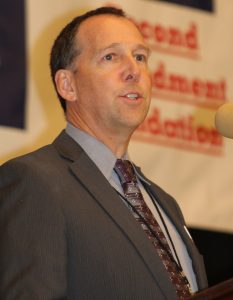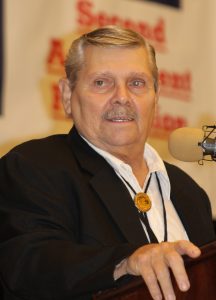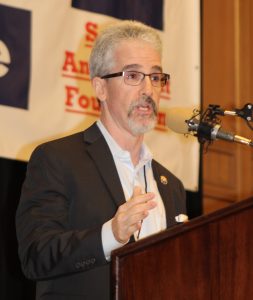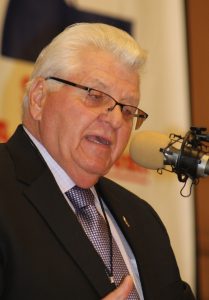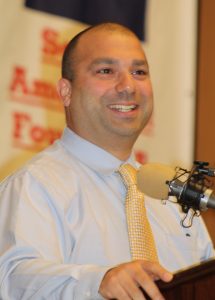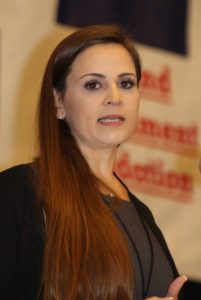By Dave Workman | Senior Editor
“The war against gun rights has gone nuclear!”
That was the assessment from Alan Gottlieb, founder and executive vice president of the Second Amendment Foundation and chairman of the Citizens Committee for the Right to Keep and Bear Arms as he opened the 34th annual Gun Rights Policy Conference (GRPC) in Phoenix.
From all indications, he was being conservative in his description. Recent months have seen Democrat presidential aspirants all pushing some form of gun control, including trailing former Congressman Robert Francis “Beto” O’Rourke, who infamously threatened in the last presidential debate to confiscate semi-auto sporting rifles from law-abiding Americans. Gottlieb issued a scathing condemnation of that remark days before the conference began.
It was, according to a report in the Arizona Republic, the largest GRPC in the event’s history. With widely-reported problems facing the National Rifle Association and the 2020 elections looming, gun owners are looking for ways to direct their energies. With more than 90 speakers and some two dozen panels, this year’s conference attracted rights activists from all over the country.
Speakers included representatives from major state-level gun rights organizations, pro-rights journalists and broadcasters, the LGBTQ community, women’s groups, former NRA directors, at least one NRA lobbyist, attorneys and researchers.
Gottlieb’s opening remarks were aimed at energizing those activists, and they scored a direct hit.
“A few years ago,” he observed, “we were deplorables. Now we’re considered terrorists.”
He chastised the establishment media for allowing the argument to be essentially one-sided, and he noted that he gun rights movement is “up against billionaires who want to buy our civil rights.”
Still, with so much against gun owners, Gottlieb acknowledged that far-left Democrat presidential candidate “Beto” O’Rourke “did us a great big favor.”
“The Democrat agenda has become extreme,” Gottlieb said, after noting that no other Democrat candidate disagreed with O’Rourke during the last presidential debate when he declared, “Hell, yes, we’re going to take your AR15, your AK47!”
Gottlieb’s opening address was a perfect lead-in to the federal affairs briefing from Mark Barnes, principal at Mark Barnes & Associates, a national and international firearms legal and policy firm.
Barnes predicted that some of the extreme gun control measures already introduced in Congress will not pass. He concurred that Democrat presidential candidates have become “virulent” in their anti-gun approaches, and he referred the audience to a report from the U.S. Secret Service earlier this year on mass shootings.
“It would be well advised,” he said, “for our policy makers in Washington to read the facts.”
The document, which may be read here, covers but 16 pages, but they are loaded with information. Barnes encouraged the audience to read it.
Barnes was critical of the current “dialogue” now in Washington, D.C. which focuses on firearms and not on preventing mass shootings.
Meanwhile, he alluded to a proposal that surfaced just before the conference convened, that apparently was a product of the Justice Department. It suggests firearms transfers be made through “licensed transfer agents” with some access to the National Instant Background Check System (NICS). Under this scenario, buyer information would not be retained.
‘It’s not a new idea, it’s an old idea,” he said. “Whether it will gain any currency in Washington, D.C., we’ll just have to see.”
‘Elephant in the Room’
The first panel dealt with the controversy surrounding the National Rifle Association. It featured Rob Pincus, vice president of the Second Amendment Organization and director of media relations for “Save the Second,” a maverick group ostensibly to make the NRA stronger, more effective and relevant.
“We must reform the leadership and the bylaws,” says the group statement at its Facebook page.
Pincus, who has become somewhat “the face” of NRA member discontent, led the discussion, reminding the audience, “We are the gun lobby, we are the voters, we are the advocates.” He insisted that he wants the NRA to be stronger heading into the election cycle, and that the “voice” of the so-called “gun lobby” is “our voice.” With more than 100 million gun owners in the country, unity is a must, he stressed. He said that unity must come from cooperation and collaboration, not “falling in line.”
“There are hundreds of millions of firearms in America that are used responsibly every day,” he commented.
Pincus was joined on the stage by Jim Irvine, president of the Buckeye Firearms Association (BFA). Noting that everyone hopes things will work out, he reminded the audience that “Hope is not a plan.”
He explained that while no other organization could replace the NRA, other organizations need to “step up to the plate.” That would fall on the shoulders of state organizations such as BFA, which could turn out “an army” of Buckeye gun owners. The strategy would involve working with gun stores and other businesses, and build that army through “targeted (voter) registration.”
It is going to be a monumental challenge, both speakers intimated, but the stakes are too high to not try.
“Failure is not an option,” Irvine said.
State Legislative Affairs
Two panels were convened to discuss the political situation at the state level, and the consensus is that things could use some improvement.
Former NRA Director John Cushman, president of the Sportsmen’s Association for Firearms Education (SAFE) in New York said people would be amazed at the number of anti-gun bills introduced in the Empire State. He also reported more anti-gun protestors showing up in recent times, revealing that “Some of those people have become so fanatical they wish harm on others.”
New York suffers from having a totally anti-gun governor in Andrew Cuomo, and the legislature seems warm to gun control on an ever increasing level.
He told the hundreds of activists in the audience that “it’s up to use to make sure they don’t go farther.”
Craig DeLuz, legislative advocate with the Firearms Policy Coalition, cautioned the audience about lawmakers who are determined to “do something” just to be able to say they did something. Often, he said, that “something didn’t do anything.”
“Something clearly didn’t work,” he remarked.
Criticizing so-called “red flag” laws known as Extreme Risk Protection orders, DeLuz warned that laws currently being passed and tested in California are going to spread, and he was concerned about “rights rationing” schemes like one-gun-per-month laws.
“What starts in California does not stay in California,” he observed.
Dave Kopp, president of the Arizona Citizens Defense League identified a big problem: “Our enemies have money…that’s what we’re up against.” He said gun control organizations such as billionaire Michael Bloomberg’s Everytown for Gun Safety have ambition and motivation, and they are energized.
“These guys are strong and they’re well-funded,” Kopp noted.
The way to fight back is to simply “show up.” Don’t sit on the sidelines, get involved, Kopp explained. Rights activists need to do something besides watch, and don’t be deterred by the big money.
From Illinois, Richard Pearson, executive director of the Illinois State Rifle Association, offered another strategy: lawsuits. His group was involved in the 2010 case of McDonald v. City of Chicago, and they have also been plaintiffs in several other lawsuits, typically with SAF.
“It’s important,” he said, “for people to k now you are willing to sue them. It tends to temper them a bit.”
He also explained that Illinois may be dominated by Chicago, but the state is not like the Windy City, the farther away one gets from Lake Michigan.
“The rest of Illinois is just like America,” he quipped.
Alexander Roubian, president of the New Jersey Second Amendment Society, told the audience that the Garden State is not all gloom and doom. His group has had “many legal victories.” They have sued 30 communities for violating state gun laws, and “won every time.”
His strategy is to “identify the enemy, isolate them and then attack.”
Roubian acknowledged that he operates “behind enemy lines,” since New Jersey is not friendly to the Second Amendment. But gun owners cannot afford to lose this fight, he warned.
“It’s time to wake up,” he commented. “If the Second Amendment dies, America dies with it.”
Rounding out the first state panel, Holly Sullivan, executive board member with the Connecticut Citizens Defense League, said her organization has 48,000 members, despite being the 48th smallest state in the union.
She said one in seven residents is licensed to carry firearms legally, and that her organization works with other gun rights groups to make it all happen.
On a personal level, Sullivan acknowledged that she is a mother, and that she lives just a few miles from Sandy Hook Elementary, scene of the tragic 2012 mass shooting that killed 26 people including 20 youngsters. Sullivan, looking at gun control groups such as Moms Demand Action, told the audience that “we must change the dialogue.”
“They don’t speak for me,” she stated.
(An earlier version of this report misidentified Craig DeLuz as president of the Nebraska Firearms Association.)

